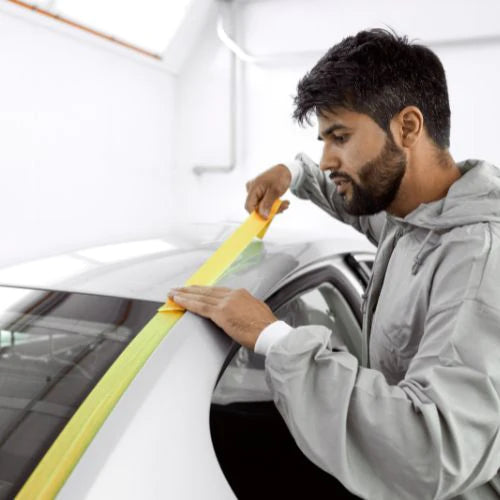In the realm of automotive painting, the difference between a flawless finish and a lackluster result often boils down to meticulous preparation. Among the various preparatory steps, the proper use of masking and taping emerges as a fundamental necessity. In this blog post, we'll delve into the significance of these seemingly simple yet critical processes in achieving professional-grade automotive painting.
The Canvas Matters: Why Proper Prep is Essential
Imagine an artist preparing to create a masterpiece. Before the strokes of the brush, the canvas must be clean, smooth, and free from imperfections. Similarly, the surfaces to be painted on an automobile demand a pristine canvas. Proper preparation ensures that the paint adheres seamlessly, creating a durable and aesthetically pleasing finish.
The Role of Masking and Taping
1. Precision is Paramount:
Automotive painting often involves intricate designs, multi-tone finishes, or specific areas that require color separation. Masking and taping provide the precision needed to isolate these areas, preventing overspray and ensuring that each section receives the right treatment.
2. Protecting the Unpainted Areas:
A vehicle consists of various components, from windows to tires and trim. Proper masking and taping shield these areas from unintended paint contact. This protection is vital to maintain the integrity of non-painted surfaces and prevent time-consuming cleanup or corrections.
3. Sealing Out Contaminants:
Dust and debris in the painting environment can compromise the quality of the finish. Masking and taping create a barrier, sealing out contaminants that could mar the final result. This not only enhances the visual appeal of the paint job but also contributes to its longevity.
4. Efficient Workflow:
Time is money, especially in the automotive industry. Properly prepped surfaces, facilitated by effective masking and taping, allow for a more efficient workflow. Technicians can focus on the painting process without the need for constant interruptions to correct mistakes or clean up overspray.
The Masking and Taping Process
1. Surface Cleaning:
Begin by thoroughly cleaning the surfaces to be painted. Any dirt, grease, or residue can affect paint adhesion.
2. Selecting the Right Materials:
Different areas may require specific types of masking materials. Choose high-quality masking tape, paper, plastic, or specialty masking materials based on the requirements of each section.
3. Precision Application:
Carefully apply masking materials, ensuring they adhere tightly to the surfaces. Properly sealed edges prevent paint bleed and maintain clean lines.
4. Strategic Planning:
Plan the masking and taping process strategically. Start with areas that need the most precision and work systematically to cover larger sections.
5. Quality Inspection:
Before proceeding with painting, conduct a thorough inspection of the masked and taped areas. Any gaps or imperfections in the masking should be addressed to guarantee a flawless outcome.
Elevate Your Automotive Painting Experience
In the world of automotive painting, attention to detail is non-negotiable. Proper prep with masking and taping is not merely a step; it's an art form that ensures the canvas is ready for the strokes of the spray gun. From protecting non-painted surfaces to facilitating a seamless workflow, the impact of meticulous preparation cannot be overstated.
As you embark on your next automotive painting project, remember that the key to a stunning finish lies in the details of the prep work. Invest the time and effort in proper masking and taping and witness the transformation of your vehicle into a work of art. Elevate your automotive painting experience by embracing the necessity of proper prep—where masking and taping become the brushstrokes that define excellence.
Spray Filters Direct - Your Partner in Spray Booth Excellence!!!

